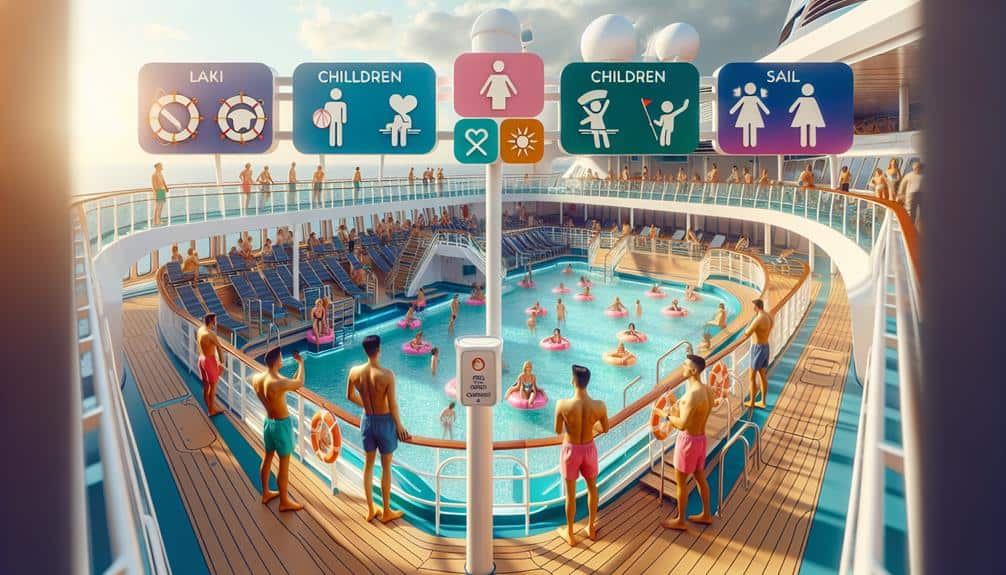On cruise ships, children benefit from strict safety measures. Age-appropriate supervision guidelines guarantee clear responsibilities and accountability. Childproofing includes safety gates, locks, and inspections to prevent accidents. Emergency drills familiarize passengers with protocols, exits, and crew instructions. Dedicated safety briefings engage children and involve parents in emergency preparedness. Pool safety is guaranteed with lifeguards, barriers, swim lessons, and flotation devices. These detailed protocols prioritize children's safety at sea.
Key Points
- Supervised activities with clear responsibilities and sign-in/out procedures.
- Childproof cabins with safety gates, locks, and secured furniture.
- Conduct emergency drills, familiarize with evacuation protocols, and follow crew instructions.
- Engage children with dedicated safety briefings and interactive activities.
- Implement pool safety with lifeguards, barriers, swim lessons, and flotation devices.
Age-appropriate Supervision Guidelines
To guarantee the safety of children on cruise ships, establish age-appropriate supervision guidelines that clearly outline responsibilities and expectations for both parents and cruise staff. Parental responsibilities are paramount in ensuring children's safety onboard.
Parents should be informed about sign-in and out procedures for kids participating in supervised activities. It's vital for parents to adhere to these procedures diligently to maintain accountability for their children's whereabouts.
Additionally, thorough staff training is essential. Cruise staff must be well-versed in handling various situations that may arise while children are under their care. Training should encompass emergency protocols, conflict resolution strategies, and effective communication techniques to ensure the well-being of all children onboard.
Staff should be equipped to handle onboard activities safely and supervise children according to the established guidelines.
Childproofing Cabins and Common Areas
Establish childproofing measures in cabins and common areas to create a safe environment for children on cruise ships. When childproofing cabins, consider implementing safety gates at the entrance to prevent young children from accessing potentially hazardous areas like balconies or stairwells. Additionally, make sure that cabinets and drawers containing items such as cleaning supplies, medications, or small objects are equipped with childproof locks to prevent accidental ingestion or harm.
Utilize a childproofing checklist to systematically evaluate and address potential risks in cabins and common areas. This checklist should include items such as securing heavy furniture to prevent tipping, covering electrical outlets, and removing any dangling cords or blinds that could pose strangulation risks. Moreover, inspect the cabin for any sharp edges or corners that may need to be padded to prevent injuries during play.
In common areas, such as lounges or recreational spaces, ensure that childproofing measures are in place to safeguard children from potential hazards. This may include securing loose cables, making certain that play areas are free from debris or tripping hazards, and providing adequate supervision to prevent accidents.
Emergency Drills and Procedures
Make sure all passengers, including children, are familiar with emergency drills and procedures onboard the cruise ship. Emergency evacuation protocols are essential for guaranteeing the safety of all individuals in the event of unforeseen circumstances. Safety drills play a pivotal role in preparing passengers, especially children, for emergencies that may arise while at sea.
Upon boarding the cruise ship, familiarize yourself and your children with the location of emergency exits, life jackets, and assembly points. During safety drills, pay close attention to the crew's instructions on emergency procedures, including how to properly wear a life jacket and where to gather in case of evacuation.
In the event of an emergency, stay calm and follow crew instructions promptly. Ensure that children are accompanied by adults and accounted for at all times. Practice good communication with your children regarding emergency procedures to instill a sense of preparedness and safety awareness.
Dedicated Childrens Safety Briefings
Children's safety briefings are essential onboard cruise ships to ensure their preparedness for emergencies. These briefings are tailored to engage children through interactive activities, ensuring they understand safety protocols in a fun and informative manner. Parental involvement is encouraged during these sessions to reinforce the importance of safety measures and to facilitate a family-oriented approach to emergency preparedness.
Interactive activities such as quizzes, role-playing scenarios, and hands-on demonstrations are commonly used during children's safety briefings. These methods help children grasp crucial safety information while keeping them engaged and attentive. Additionally, involving parents in these briefings allows families to discuss safety procedures together, enhancing overall comprehension and readiness.
Pool and Water Safety Protocols
To enhance safety around pools and water areas on cruise ships, adherence to specific protocols is crucial. Lifeguard presence is essential to monitor swimmers and respond to emergencies promptly. Safety barriers, such as fences and locked gates, help prevent unauthorized access to the pool area, reducing the risk of accidents.
Swim lessons are a proactive measure to guarantee that children and adults alike have the necessary skills to navigate the water safely. Cruise ships often provide swim lessons for guests to enhance their swimming abilities and water confidence. Additionally, floatation devices should be readily available near the pool for swimmers who may need extra support in the water.
Frequently Asked Questions
Are There Any Specific Guidelines for Children With Special Needs or Medical Conditions on Cruise Ships?
In emergency situations on cruise ships, specific guidelines exist for children with special needs or medical conditions. Medical staff and equipment are available to provide necessary accommodations, enhancing safety and ensuring their well-being throughout the voyage.
What Measures Are in Place to Prevent Children From Wandering off or Getting Lost on a Cruise Ship?
To prevent children from getting lost on a cruise ship, child supervision protocols and onboard safety measures are rigorously enforced. Crew members are trained to monitor designated areas and make sure children are accounted for at all times.
How Are Children Monitored and Accounted for During Onboard Activities and Excursions?
In the vast sea of activities, child supervision is paramount. Tracking devices and rigorous communication protocols guarantee their safety. Emergency protocols stand ready. Trust the system; your child's security is our top priority.
Are There Any Restrictions on Children Accessing Certain Areas of the Ship for Safety Reasons?
Child supervision protocols on cruise ships include restricted areas where children are not allowed unsupervised, boosting safety. These restrictions guarantee children are kept safe and prevent accidents in potentially hazardous locations onboard.
How Are Children's Dietary Restrictions or Allergies Accommodated in Onboard Dining Options?
When it comes to children's dietary restrictions or allergies on cruise ships, the menu options are crafted to accommodate various needs. Special requests can be made to guarantee safe and enjoyable dining experiences for all young passengers.




